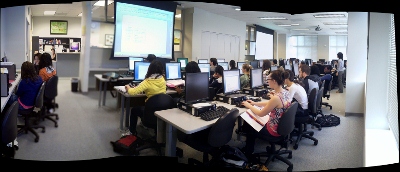Archive
Example 8: Auralog Tell-Me-More Speech Recognition Test
How usable is the Auralog Speech Recognition for language learning? This test, by a non-native speaker of English, gives some authentic data points.
The test shows: Auralog Speech Recognition
- can be easily tripped up; however, by errors that a non-native language learner would not normally make
- more concerning is that the built-in AI, instead of e.g. escalating to additional feedback or help, like the pronunciation waveforms (which in itself seem to encourage only repeated attempts to mimic a given intonation, while not being fine-grained enough to spot mispronunciations on a word, let alone letter level) – lowers the requirements when a speaker repeatedly fails (which in extreme seems to amount to “waving through” any utterance).
- the preset dialogue – only few exercises including wrong answer options, most exercises testing only a comprehensible pronunciation of a given reading text which makes the exercise much easier for the built-in speech recognition, but also much less realistic and useful for a language learner (or more of a reading exercise).
Language Lab Techniques for (Self-)Evaluation and Grading of Student Recordings with Audacity
This quick and dirty (not narrated and uncut: time is money, and storage cheap…) video  demonstrates a technique in (the free audio editor) Audacity with which instructors and students can more easily (self-)evaluate parallel recordings from (be it model imitation, question-response, or consecutive interpreting exercises in) the language lab (in this case the output of a Sanako Study1200, which automatically gets stored in a folder on network share):
demonstrates a technique in (the free audio editor) Audacity with which instructors and students can more easily (self-)evaluate parallel recordings from (be it model imitation, question-response, or consecutive interpreting exercises in) the language lab (in this case the output of a Sanako Study1200, which automatically gets stored in a folder on network share):
|
When? |
What? |
|
0,00 |
how to load 10 student files à 5mb = 2:30min (but as a batch, allowing you do something else in the foreground instead of waiting) |
|
2,50 |
how to select a part of the timeline to play |
|
3,00 |
how to move tracks up to more easily work with them and the menu |
|
3,30 |
how to play all tracks simultaneously (choir, normally not very useful for evaluation) |
|
3,40 |
how to play only one track (solo): evaluate & compare |
Automating Auralog Tell-Me-More with AutoIt. Presentation at EUROCALL 2008
Auralog Tell-Me-More is a leading language learning software system which provides a vast amount of content in an advanced technical infrastructure that we found lacking in usability within an higher education language learning environment.
AutoIt is a programming language for GUI automation which I used to better integrate the Auralog software into the higher education language learning process, including
- programmatic
 creation of courses and accounts
creation of courses and accounts - programmatic extraction and digital repository management for over 30.000 learning units.

- programmatic creation of 10,000s of learning paths,

Results  were presented (screencast) at EUROCALL 2008: “Automating Auralog (pdf)”:
were presented (screencast) at EUROCALL 2008: “Automating Auralog (pdf)”:
creates 100s of courses  , creates
, creates  and enrols
and enrols  up to 2,000 student accounts every term,
up to 2,000 student accounts every term,
- content extraction
 produces files
produces files for adding search
for adding search  and spreadsheet for sort/filter functionality:
and spreadsheet for sort/filter functionality: 
- learning path creation.
More detailed background information here: plagwitz_auralog_accounts_project_pub.pdf, plagwitz_auralog_project_pub.pdf


